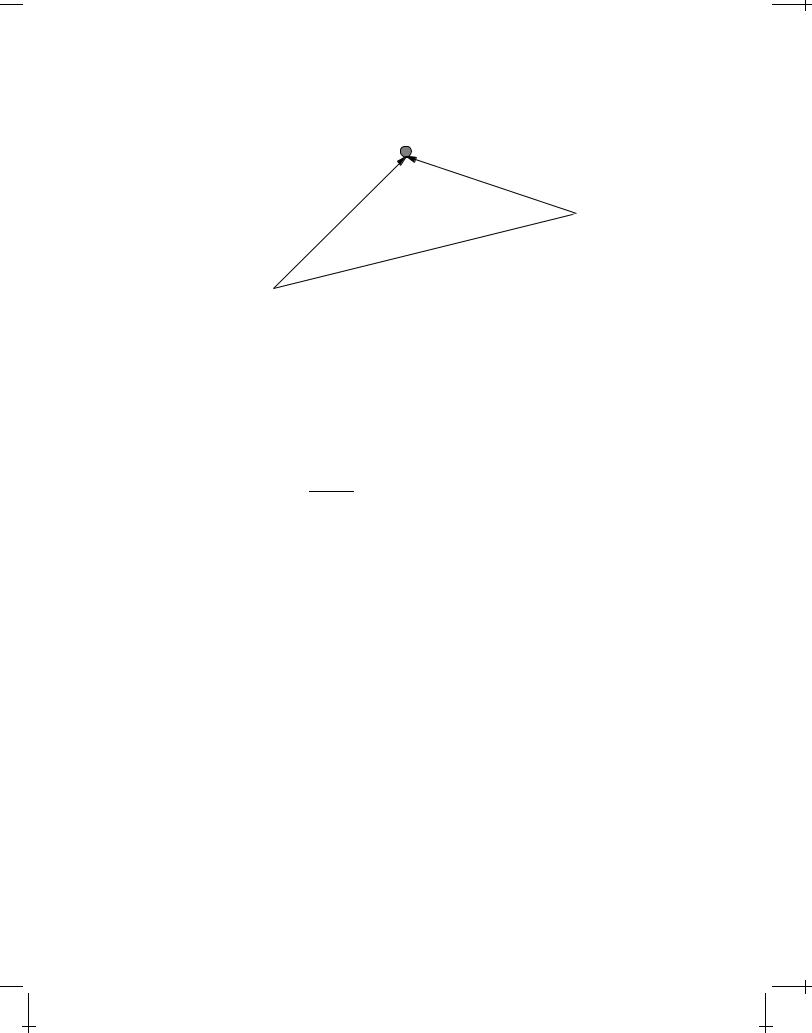
electrodynamics / Electromagnetic Field Theory - Bo Thide
.pdf
v |
|
F.3.9 |
Field tensor . . . . . . . . . . . . . . . . . . . . . . . |
153 |
F.4 Vector Relations . . . . . . . . . . . . . . . . . . . . . . . . . |
153 |
|
F.4.1 |
Spherical polar coordinates . . . . . . . . . . . . . . . |
154 |
|
Base vectors . . . . . . . . . . . . . . . . . . . . . . |
154 |
|
Directed line element . . . . . . . . . . . . . . . . . . |
154 |
|
Solid angle element . . . . . . . . . . . . . . . . . . . |
154 |
|
Directed area element . . . . . . . . . . . . . . . . . |
154 |
|
Volume element . . . . . . . . . . . . . . . . . . . . |
154 |
F.4.2 |
Vector formulae . . . . . . . . . . . . . . . . . . . . . |
154 |
|
General relations . . . . . . . . . . . . . . . . . . . . |
154 |
|
Special relations . . . . . . . . . . . . . . . . . . . . |
156 |
|
Integral relations . . . . . . . . . . . . . . . . . . . . |
157 |
Bibliography . . . . . . . . . . . . . . . . . . . . . . . . . . . . . |
157 |
|
Appendices |
|
148 |
M Mathematical Methods |
159 |
|
M.1 Scalars, Vectors and Tensors . . . . . . . . . . . . . . . . . . |
159 |
|
M.1.1 |
Vectors . . . . . . . . . . . . . . . . . . . . . . . . . |
159 |
|
Radius vector . . . . . . . . . . . . . . . . . . . . . . |
159 |
M.1.2 |
Fields . . . . . . . . . . . . . . . . . . . . . . . . . . |
161 |
|
Scalar fields . . . . . . . . . . . . . . . . . . . . . . . |
161 |
|
Vector fields . . . . . . . . . . . . . . . . . . . . . . |
161 |
|
Tensor fields . . . . . . . . . . . . . . . . . . . . . . |
162 |
|
Example M.1 Tensors in 3D space . . . . . . . . . . . . |
164 |
M.1.3 |
Vector algebra . . . . . . . . . . . . . . . . . . . . . |
167 |
|
Scalar product . . . . . . . . . . . . . . . . . . . . . |
167 |
|
Example M.2 Inner products in complex vector space . . . |
167 |
|
Example M.3 Scalar product, norm and metric in Lorentz |
|
|
space . . . . . . . . . . . . . . . . . . . . . |
168 |
|
Example M.4 Metric in general relativity . . . . . . . . . |
168 |
|
Dyadic product . . . . . . . . . . . . . . . . . . . . . |
169 |
|
Vector product . . . . . . . . . . . . . . . . . . . . . |
170 |
M.1.4 |
Vector analysis . . . . . . . . . . . . . . . . . . . . . |
170 |
|
The del operator . . . . . . . . . . . . . . . . . . . . |
170 |
|
Example M.5 The four-del operator in Lorentz space . . . |
171 |
|
The gradient . . . . . . . . . . . . . . . . . . . . . . |
172 |
|
Example M.6 Gradients of scalar functions of relative dis- |
|
|
tances in 3D . . . . . . . . . . . . . . . . . . |
172 |
|
The divergence . . . . . . . . . . . . . . . . . . . . . |
173 |
Draft version released 13th November 2000 at 22:01. |
Downloaded from http://www.plasma.uu.se/CED/Book |
|
|

vi |
CONTENTS |
|
Example M.7 Divergence in 3D . . . . . . . . . . . . . |
173 |
The Laplacian . . . . . . . . . . . . . . . . . . . . . . |
173 |
Example M.8 The Laplacian and the Dirac delta . . . . . |
173 |
The curl . . . . . . . . . . . . . . . . . . . . . . . . . |
174 |
Example M.9 The curl of a gradient . . . . . . . . . . . |
174 |
Example M.10 The divergence of a curl . . . . . . . . . |
175 |
M.2 Analytical Mechanics . . . . . . . . . . . . . . . . . . . . . . |
176 |
M.2.1 Lagrange's equations . . . . . . . . . . . . . . . . . . |
176 |
M.2.2 Hamilton's equations . . . . . . . . . . . . . . . . . . |
176 |
Bibliography . . . . . . . . . . . . . . . . . . . . . . . . . . . . . |
177 |
Downloaded from http://www.plasma.uu.se/CED/Book |
Draft version released 13th November 2000 at 22:01. |
|
|

List of Figures
1.1 |
Coulomb interaction . . . . . . . . . . . . . . . . . . . . . . |
2 |
1.2 |
Ampère interaction . . . . . . . . . . . . . . . . . . . . . . . |
5 |
1.3Moving loop in a varying B field . . . . . . . . . . . . . . . . 12
5.1 Relative motion of two inertial systems . . . . . . . . . . . . 52
5.2Rotation in a 2D Euclidean space . . . . . . . . . . . . . . . . 59
5.3Minkowski diagram . . . . . . . . . . . . . . . . . . . . . . . 59
6.1Linear one-dimensional mass chain . . . . . . . . . . . . . . . 76
8.1 |
Radiation in the far zone . . . . . . . . . . . . . . . . . . . . |
98 |
8.2 |
Radiation from a moving charge in vacuum . . . . . . . . . . |
112 |
8.3An accelerated charge in vacuum . . . . . . . . . . . . . . . . 114
8.4Angular distribution of radiation during bremsstrahlung . . . . 128
8.5Location of radiation during bremsstrahlung . . . . . . . . . . 129
8.6Radiation from a charge in circular motion . . . . . . . . . . . 133
8.7Synchrotron radiation lobe width . . . . . . . . . . . . . . . . 135
8.8 |
The perpendicular field of a moving charge . . . . . . . . . . |
138 |
8.9 |
ˇ |
144 |
Vavilov-Cerenkov cone . . . . . . . . . . . . . . . . . . . . . |
||
M.1 |
Surface element of a material body . . . . . . . . . . . . . . . |
164 |
M.2 |
Tetrahedron-like volume element of matter . . . . . . . . . . . |
165 |
vii
|
|

|
|

To the memory of
LEV MIKHAILOVICH ERUKHIMOV
dear friend, remarkable physicist and a truly great human.
|
|

|
|

Preface
This book is the result of a twenty-five year long love affair. In 1972, I took my first advanced course in electrodynamics at the Theoretical Physics department, Uppsala University. Shortly thereafter, I joined the research group there and took on the task of helping my supervisor, professor PER-OLOF FRÖ- MAN, with the preparation of a new version of his lecture notes on Electricity Theory. These two things opened up my eyes for the beauty and intricacy of electrodynamics, already at the classical level, and I fell in love with it.
Ever since that time, I have off and on had reason to return to electrodynamics, both in my studies, research and teaching, and the current book is the result of my own teaching of a course in advanced electrodynamics at Uppsala University some twenty odd years after I experienced the first encounter with this subject. The book is the outgrowth of the lecture notes that I prepared for the four-credit course Electrodynamics that was introduced in the Uppsala University curriculum in 1992, to become the five-credit course Classical Electrodynamics in 1997. To some extent, parts of these notes were based on lecture notes prepared, in Swedish, by BENGT LUNDBORG who created, developed and taught the earlier, two-credit course Electromagnetic Radiation at our faculty.
Intended primarily as a textbook for physics students at the advanced undergraduate or beginning graduate level, I hope the book may be useful for research workers too. It provides a thorough treatment of the theory of electrodynamics, mainly from a classical field theoretical point of view, and includes such things as electrostatics and magnetostatics and their unification into electrodynamics, the electromagnetic potentials, gauge transformations, covariant formulation of classical electrodynamics, force, momentum and energy of the electromagnetic field, radiation and scattering phenomena, electromagnetic waves and their propagation in vacuum and in media, and covariant Lagrangian/Hamiltonian field theoretical methods for electromagnetic fields, particles and interactions. The aim has been to write a book that can serve both as an advanced text in Classical Electrodynamics and as a preparation for studies in Quantum Electrodynamics and related subjects.
In an attempt to encourage participation by other scientists and students in
xi
|
|

xii |
PREFACE |
|
the authoring of this book, and to ensure its quality and scope to make it useful in higher university education anywhere in the world, it was produced within a World-Wide Web (WWW) project. This turned out to be a rather successful move. By making an electronic version of the book freely down-loadable on the net, I have not only received comments on it from fellow Internet physicists around the world, but know, from WWW `hit' statistics that at the time of writing this, the book serves as a frequently used Internet resource. This way it is my hope that it will be particularly useful for students and researchers working under financial or other circumstances that make it difficult to procure a printed copy of the book.
I am grateful not only to Per-Olof Fröman and Bengt Lundborg for providing the inspiration for my writing this book, but also to CHRISTER WAHLBERG at Uppsala University for interesting discussions on electrodynamics in general and on this book in particular, and to my former graduate students MATTIAS
WALDENVIK and TOBIA CAROZZI as well as ANDERS ERIKSSON, all at the
Swedish Institute of Space Physics, Uppsala Division, and who have participated in the teaching and commented on the material covered in the course and in this book. Thanks are also due to my long-term space physics colleague HELMUT KOPKA of the Max-Planck-Institut für Aeronomie, Lindau, Germany, who not only taught me about the practical aspects of the of highpower radio wave transmitters and transmission lines, but also about the more delicate aspects of typesetting a book in TEX and LATEX. I am particularly indebted to Academician professor VITALIY L. GINZBURG for his many fascinating and very elucidating lectures, comments and historical footnotes on electromagnetic radiation while cruising on the Volga river during our joint Russian-Swedish summer schools.
Finally, I would like to thank all students and Internet users who have downloaded and commented on the book during its life on the World-Wide Web.
I dedicate this book to my son MATTIAS, my daughter KAROLINA, my high-school physics teacher, STAFFAN RÖSBY, and to my fellow members of
the CAPELLA PEDAGOGICA UPSALIENSIS.
Uppsala, Sweden |
BO THIDÉ |
November, 2000 |
|
Downloaded from http://www.plasma.uu.se/CED/Book |
Draft version released 13th November 2000 at 22:01. |
|
|

1
Classical
Electrodynamics
Classical electrodynamics deals with electric and magnetic fields and interactions caused by macroscopic distributions of electric charges and currents. This means that the concepts of localised charges and currents assume the validity of certain mathematical limiting processes in which it is considered possible for the charge and current distributions to be localised in infinitesimally small volumes of space. Clearly, this is in contradiction to electromagnetism on a truly microscopic scale, where charges and currents are known to be spatially extended objects. However, the limiting processes used will yield results which are correct on small as well as large macroscopic scales.
In this Chapter we start with the force interactions in classical electrostatics and classical magnetostatics and introduce the static electric and magnetic fields and find two uncoupled systems of equations for them. Then we see how the conservation of electric charge and its relation to electric current leads to the dynamic connection between electricity and magnetism and how the two can be unified in one theory, classical electrodynamics, described by one system of coupled dynamic field equations.
1.1 Electrostatics
The theory that describes physical phenomena related to the interaction between stationary electric charges or charge distributions in space is called electrostatics.
1.1.1 Coulomb's law
It has been found experimentally that in classical electrostatics the interaction between two stationary electrically charged bodies can be described in terms of a mechanical force. Let us consider the simple case described by Figure 1.1.1.
1
|
|

2 |
CLASSICAL ELECTRODYNAMICS |
|
q
x x0
x
 q0
q0
x0
O
FIGURE 1.1: Coulomb's law describes how a static electric charge q, located at a point x relative to the origin O, experiences an electrostatic force from a static electric charge q0 located at x0.
Let F denote the force acting on a charged particle with charge q located at x, due to the presence of a charge q0 located at x0. According to Coulomb's law this force is, in vacuum, given by the expression
F(x) = |
qq0 |
x x0 |
= |
|
qq0 |
r |
1 |
|
(1.1) |
|
4 "0 jx x0j3 |
4 "0 |
jx x0j |
||||||||
|
|
|
|
|||||||
where we have used results from Example M.6 on page 172. In SI units, which we shall use throughout, the force F is measured in Newton (N), the charges q and q0 in Coulomb (C) [= Ampère-seconds (As)], and the length jx x0j in metres (m). The constant "0 = 107=(4 c2) 8:8542 10 12 Farad per metre (F/m) is the vacuum permittivity and c 2:9979 108 m/s is the speed of light in vacuum. In CGS units "0 = 1=(4 ) and the force is measured in dyne, the charge in statcoulomb, and length in centimetres (cm).
1.1.2 The electrostatic field
Instead of describing the electrostatic interaction in terms of a “force action at a distance,” it turns out that it is often more convenient to introduce the concept of a field and to describe the electrostatic interaction in terms of a static vectorial electric field Estat defined by the limiting process
E |
stat def |
lim |
F |
(1.2) |
|||
|
q |
||||||
q |
! |
0 |
|
||||
|
|
|
|
|
|
||
where F is the electrostatic force, as defined in Equation (1.1), from a net charge q0 on the test particle with a small electric net charge q. Since the
Downloaded from http://www.plasma.uu.se/CED/Book |
Draft version released 13th November 2000 at 22:01. |
|
|
